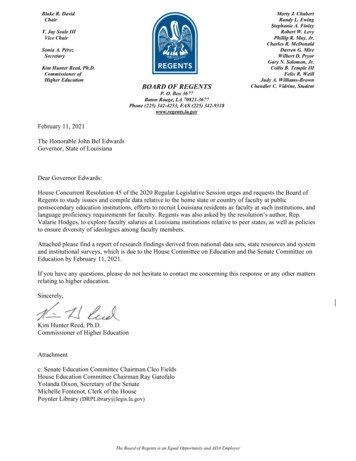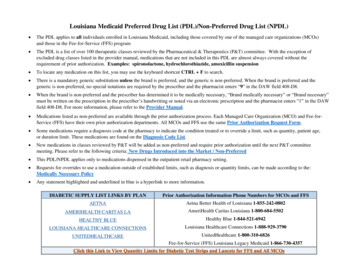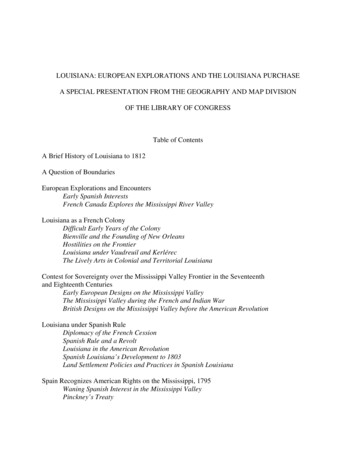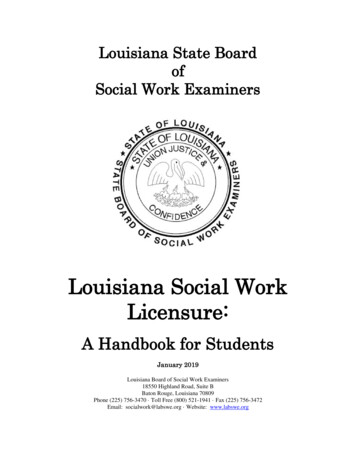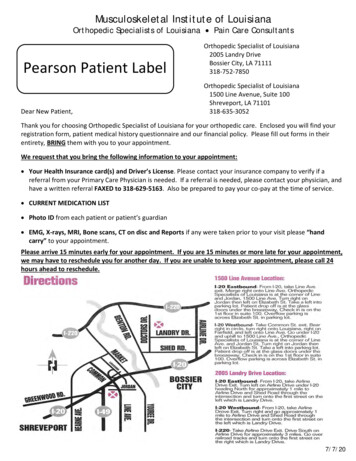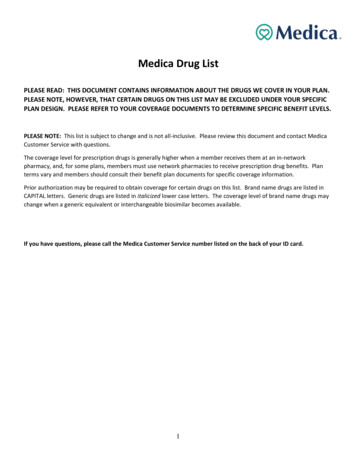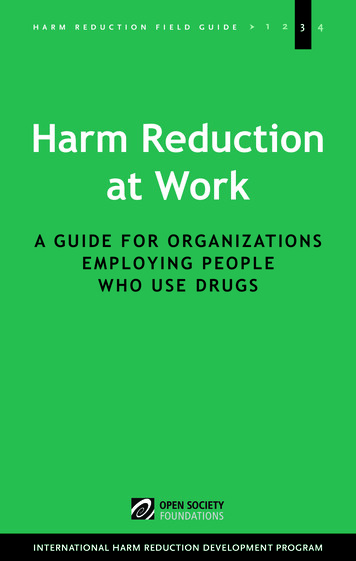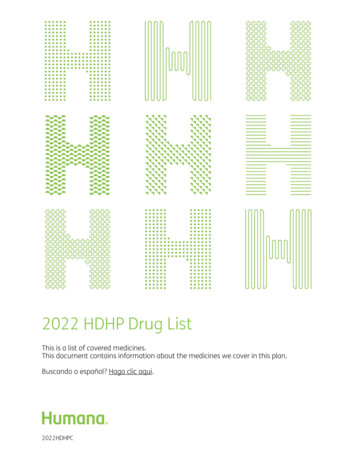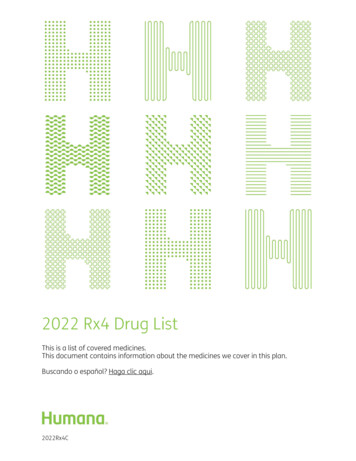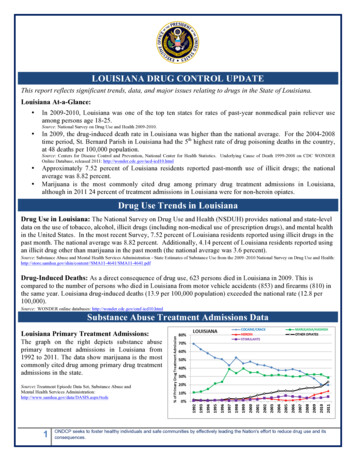
Transcription
LOUISIANA DRUG CONTROL UPDATEThis report reflects significant trends, data, and major issues relating to drugs in the State of Louisiana.Louisiana At-a-Glance: In 2009-2010, Louisiana was one of the top ten states for rates of past-year nonmedical pain reliever useamong persons age 18-25.Source: National Survey on Drug Use and Health 2009-2010. In 2009, the drug-induced death rate in Louisiana was higher than the national average. For the 2004-2008time period, St. Bernard Parish in Louisiana had the 5th highest rate of drug poisoning deaths in the country,at 48 deaths per 100,000 population.Source: Centers for Disease Control and Prevention, National Center for Health Statistics. Underlying Cause of Death 1999-2008 on CDC WONDEROnline Database, released 2011: http://wonder.cdc.gov/ucd-icd10.html Approximately 7.52 percent of Louisiana residents reported past-month use of illicit drugs; the nationalaverage was 8.82 percent.Marijuana is the most commonly cited drug among primary drug treatment admissions in Louisiana,although in 2011 24 percent of treatment admissions in Louisiana were for non-heroin opiates.Drug Use Trends in LouisianaDrug Use in Louisiana: The National Survey on Drug Use and Health (NSDUH) provides national and state-leveldata on the use of tobacco, alcohol, illicit drugs (including non-medical use of prescription drugs), and mental healthin the United States. In the most recent Survey, 7.52 percent of Louisiana residents reported using illicit drugs in thepast month. The national average was 8.82 percent. Additionally, 4.14 percent of Louisiana residents reported usingan illicit drug other than marijuana in the past month (the national average was 3.6 percent).Source: Substance Abuse and Mental Health Services Administration - State Estimates of Substance Use from the 2009–2010 National Survey on Drug Use and -4641/SMA11-4641.pdfDrug-Induced Deaths: As a direct consequence of drug use, 623 persons died in Louisiana in 2009. This iscompared to the number of persons who died in Louisiana from motor vehicle accidents (853) and firearms (810) inthe same year. Louisiana drug-induced deaths (13.9 per 100,000 population) exceeded the national rate (12.8 per100,000).Source: WONDER online databases: http://wonder.cdc.gov/cmf-icd10.htmlSubstance Abuse Treatment Admissions DataLouisiana Primary Treatment Admissions:The graph on the right depicts substance abuseprimary treatment admissions in Louisiana from1992 to 2011. The data show marijuana is the mostcommonly cited drug among primary drug treatmentadmissions in the state.Source: Treatment Episode Data Set, Substance Abuse andMental Health Services px#teds1ONDCP seeks to foster healthy individuals and safe communities by effectively leading the Nation's effort to reduce drug use and itsconsequences.
Prescription Drug AbuseONDCP’s Efforts to Combat PrescriptionDrug AbusePrescription drug abuse is the ation’s Prescription Drug AbusePreventionPlanentitled“Epidemic:Responding to America’s Prescription DrugAbuse Crisis,” provides a national frameworkfor reducing prescription drug diversion andabuse by supporting the expansion of mmending secure, more convenient, andenvironmentally responsible disposal methods toremove expired, unused, or unneededmedications from the home; supportingeducation for patients and healthcare providers; and reducing the prevalence of pill mills and doctor shoppingthrough enforcement efforts.State-Level Action: Prescription Drug Monitoring Programs (PDMPs)PDMPs track controlled substances prescribed by authorized practitioners and dispensed by pharmacies.PDMPs serve a number of functions, including assisting in patient care, providing early warning signs of drugepidemics, and detecting drug diversion and insurance fraud. Forty-one states have operational PDMP programsestablished by state legislation and funded by a combination of state and Federal funds. An additional 9 statesand territories have a prescription drug monitoring program authorized, but not yet operational. Adequateresourcing, increasing the number of states with operational PDMPs, and development of state-to-stateinformation-sharing systems would significantly help reduce prescription drug diversion and abuse.Louisiana’s Prescription Monitoring Program was developed when Act 676 of the 2006 LouisianaLegislature authorized the Louisiana Board of Pharmacy to implement and operate an electronic system for themonitoring of controlled substances and other drugs of concern dispensed in the state. The goal of the program isto improve the state’s ability to identify and inhibit the diversion of controlled substances and other drugs of concernin an efficient and cost-effective manner and in a manner that shall not impede the appropriate utilization of thesedrugs for legitimate medical purposes.Source: Louisiana Board of Pharmacy: eralInformation.pdfState-Level Action: Drug Take-Back ProgramsA comprehensive plan to address prescription drug abuse must include proper disposal of unused, unneeded, orexpired medications. Providing individuals with a secure and convenient way to dispose of controlledsubstances will help prevent diversion and abuse of these substances and demonstrate sound environmentalstewardship. Federal rulemaking is underway and will further enhance the viability and scope of state andcommunity take-back programs. In the meantime, states are encouraged to work with the DEA to conductadditional take-back events and educate the public about safe and effective drug return and disposal.2ONDCP seeks to foster healthy individuals and safe communities by effectively leading the Nation's effort to reduce drug use and itsconsequences.
Drugged DrivingONDCP Action on Drugged DrivingIn 2007, the National Highway TrafficSafety Administration (NHTSA) found thatone in eight weekend, nighttime driverstested positive for illicit drugs. Accordingto recent Fatal Accident Reporting System(FARS) data, one in three motor vehiclefatalities (33 percent) with known drug testresults tested positive for drugs in 2009.Recognizing this growing problem, ONDCPis working to raise awareness of the dangersof drugged driving, provide increasedtraining to law enforcement in identifyingdrugged drivers, and encourage states toconsider Per Se laws to facilitate effectiveenforcement and prosecution of those whodrive with drugs in their systems.State-Level Action: Enacting Per Se Standards for ImpairmentAlthough all 50 states have laws against drugged driving, law enforcement often lacks adequate tools to enforceand prosecute drugged driving. ONDCP encourages states to develop and implement Per Se standards thatmake it illegal to drive a vehicle after taking illegal drugs. This is the same standard used successfully for 12million commercial drivers in the United States over the past two decades. Per Se standards have been adoptedin 17 states.Louisiana does not have a Per Se statute. However, according to Louisiana Revised Statues Title 14: Section98, “the crime of operating a vehicle while intoxicated is the operating of any motor vehicle under theinfluence of any controlled dangerous substance, when the operator is under the influence of a combination ofalcohol and one or more drugs which are not controlled dangerous substances and which are legally obtainablewith or without a prescription and in the case that the operator is under the influence of one or more drugswhich are not controlled dangerous substances and which are legally obtainable with or without a prescription.”Required proof: Defendant was operating a motor vehicle in Louisiana and he/she was under the influence of acontrolled dangerous substance. Refusal to submit to a drug test is admissible into evidence in criminal casesand DUI administrative hearings.Source: A State-by-State Analysis of Laws Dealing With Driving Under the Influence of Drugs, by the Walsh Group for the National Highway Traffic SafetyAdministration.ONDCP Support for Community-Based PreventionNational Anti-Drug Media CampaignONDCP’s National Youth Anti-Drug Media Campaign provides consistent and credible messages (includingthose in Native American and Alaska Native communities) to young people about drug abuse and itsconsequences. Above the Influence, a major component of the Campaign, informs and inspires youth to rejectillicit drugs and drinking via a mix of national and local advertising vehicles. The Campaign, in closepartnership with local community-based, youth-serving organizations, also conducts teen-targeted Above theInfluence activities to assist local groups with youth drug prevention work in their respective communities.3ONDCP seeks to foster healthy individuals and safe communities by effectively leading the Nation's effort to reduce drug use and itsconsequences.
The Drug Free Communities (DFC) ProgramRecognizing that local problems require local solutions, Drug Free Communities (DFC) organizations mobilizecommunities to prevent youth drug use by creating local data-driven strategies to reduce drug use in thecommunity. ONDCP works to foster the growth of new coalitions and support existing coalitions through theDFC grants. In FY 2012, the following Louisiana coalitions received grants from ONDCP: Jefferson Parrish Alliance of Concerned CitizensSource: Office of National Drug Control Policy http://www.ondcp.gov/dfc/grantee map.htmlONDCP High Intensity Drug Trafficking Area (HIDTA) County InfoThe High Intensity Drug Trafficking Areas (HIDTA) program enhances and coordinates drug control effortsamong local, state, and Federal law enforcement agencies. In designated HIDTA counties, the program providesagencies with coordination, equipment, technology, and additional resources to combat drug trafficking and itsharmful consequences in critical regions of the United States.HIDTA counties in LouisianaGulf Coast HIDTA: Bossier, Caddo, Calcasieu, East Baton Rouge, Jefferson, Lafayette, Orleans, and Ouachitaparishes. The Gulf Coast HIDTA supports 12 drug task forces and one intelligence-related initiative in Louisiana.These task forces are located within every major Louisiana city and address our primary drug threats:violent drug trafficking and the transshipment of illicit drugs and proceeds over Louisiana highways.The Gulf Coast HIDTA is currently supporting the installation of a license plate reader systemthroughout the state which will aid in efforts to identify, disrupt, and dismantle major drug traffickingorganizations.In 2010, Gulf Coast HIDTA task forces in Louisiana disrupted or dismantled over 80 drug traffickingorganizations operating within the state and beyond.4ONDCP seeks to foster healthy individuals and safe communities by effectively leading the Nation's effort to reduce drug use and itsconsequences.
Federal Grant Awards Available to Reduce Drug Use in the State of Louisiana5ONDCP seeks to foster healthy individuals and safe communities by effectively leading the Nation's effort to reduce drug use and itsconsequences.
File updated January, 2013.6ONDCP seeks to foster healthy individuals and safe communities by effectively leading the Nation's effort to reduce drug use and itsconsequences.
7ONDCP seeks to foster healthy individuals and safe communities by effectively leading the Nation's effort to reduce drug use and itsconsequences.
Louisiana At-a-Glance: In 2009-2010, Louisiana was one of the top ten states for rates of past-year nonmedical pain reliever use among persons age 18-25. Source: National Survey on Drug Use and Health 2009-2010. In 2009, the drug-induced death rate in Louisiana was higher than the national average. For the 2004-2008
